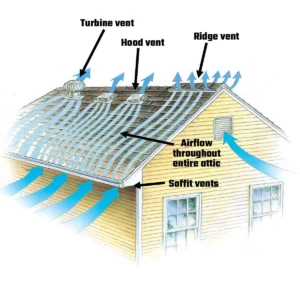Northwest Roofing is your Tarrant roof and attic ventilation expert. We are proud to be a BBB A+ local roofing contractor recommended with over 30+ years of roofing experience. Check out our customer’s testimonials.
![]()
Roof and attic ventilation is essential for maintaining a healthy and functional roof. Residential roof ventilation is based on the simple fact that warm air rises. In summer, the sun heats the air in the attic. In winter, heat from your home warms the attic air. In either season, good venting occurs when cool air can enter the attic near the eaves and exit near the peak.
Why Attic Ventilation Matters:
- Heat Regulation: Attic ventilation helps regulate temperature extremes. In hot weather, it prevents excessive heat buildup, which can damage shingles and lead to premature aging. If your attic is not properly ventilated, it can trap hot air in the summer and cold air in the winter. This can cause your HVAC system to work harder, resulting in high energy bills.
- Moisture Control: It also prevents moisture accumulation. A well-ventilated attic reduces the risk of mold, mildew, and rot. Poor ventilation can cause moisture to build up in your attic, causing mold and mildew growth.
- Ice Dam Prevention: In colder climates, proper ventilation prevents ice dams by maintaining a cold roof temperature. Ice dams form when warm air from the attic melts snow on the roof. The water then refreezes at the edges of the roof creating a dam. This can cause water to back up under the shingles and into your home.
- Roof damage: Excessive heat buildup in your attic can cause shingles to deteriorate faster than they should, leading to roof leaks and other damage. If you notice any of these signs, it’s time to add more ventilation to your attic.

Types of Attic Vents:
Intake Vents: These are located at the lowest part of the roof (under the eaves). They allow cool air to enter the attic. Examples include soffit vents and shingled intake vents.
Exhaust Vents: These vents allow hot air to escape the attic. They are typically located at the peak of the roof. Ridge vents, static vents, and turbine vents fall into this category.
Soffit Vents: Soffit vents are installed in the underside of the eaves. They allow fresh air to flow into the attic. They work best when paired with a continuous ridge vent.
Common types include small round discs and rectangular grilles. Installation involves cutting parallel lines in the soffit, creating a slot for the vent, and securing it in place.
Ventilation Guidelines:
The general rule of thumb is to install at least 1 square foot of vent for every 300 square feet of attic floor. Local building codes may vary, so always check with your roofing contractor. Consider a balanced combination of intake and exhaust vents for optimal airflow. Remember, a well-ventilated attic contributes to the longevity of your roof and overall home comfort.
Roof Ventilation Vents
The most common roof vents include ridge vents, turbine vents, power vents, soffit vents, gable vents, roof louvers, and roof jacks.
For intake air, soffit vents are best. Air can passively exit through ridge vents or hood vents. Turbine vents harness the wind to suck air out of the attic. Electric-powered vents are the ultimate air movers but aren’t necessary in most situations. Gable vents can help by allowing air in or out but don’t usually control the airflow evenly throughout the attic.
Choosing the Right Type of Roof Vent
There are many types of roof vents available. There are two main models: intake and exhaust. Both are required to properly ventilate your roof.
Intake vents allow cool air to enter the attic and help push out the hot air, freshening the space while decreasing air temperature. Intake vents are placed on the roof in one or more different areas.
Soffit vents are holes in the panel under the house’s eaves that allow fresh air to enter the attic space. Soffit vents are the intake, and roof vents are the exhaust; just like your car, one without the other will not work.
In older homes, these vents are similar in appearance to the heating and air conditioning registers inside the house. These vents are spaced around the home on the soffits to provide adequate ventilation.
Newer homes typically have long, perforated vinyl soffits that allow for maximum ventilation. Many homeowners prefer soffit vents because they don’t detract from the appearance of the house.
Drip edge vents are suitable for homes that lack the roof overhang required for a soffit vent.
When choosing a roof vent, you should consider factors such as your climate, your home’s architectural style, and your local climate.
Calculating the Number of Vents Needed
The number of roof vents you need depends on the size of your attic and the type of vent you choose.
A general rule of thumb is to have at least 1 square foot of ventilation for every 150 square feet of attic space. For example, if your attic is 900 square feet, you would need 6 square feet of ventilation. If you use ridge vents, you should have a continuous vent along the entire ridge. If using gable vents, you should have one vent on each end of the attic. If you are using soffit vents, you should have them installed along the entire length of the eaves.
In conclusion, your roof and attic ventilation plays a vital role in maintaining the health and efficiency of your home. Residential roof ventilation is a critical component of maintaining a healthy, energy-efficient, and structurally sound home.
Proper roof and attic ventilation prevents moisture, temperature extremes, and deterioration while contributing to a comfortable living environment and long-term cost savings.
Call Today for a Free Consultation:
Office: (817) 439-3065 or
Mobile: (817) 614-1630
“We’ve Got You Covered in Tarrant County!”

